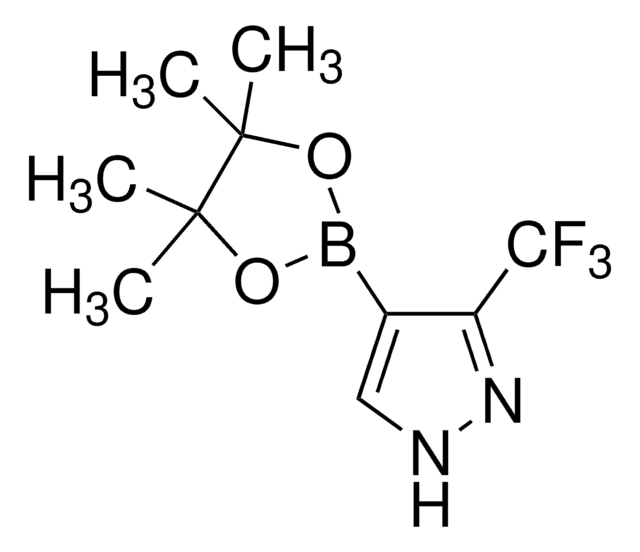803200
DTSSP (3,3′-dithiobis(sulfosuccinimidyl propionate))
Sinonimo/i:
DTSSP, bis(sulfosuccinimidyl) 3,3′-dithiobis(propionate)
About This Item
Prodotti consigliati
Saggio
≥80%
Livello qualitativo
Forma fisica
powder
PM
608.51
Impiego in reazioni chimiche
reagent type: cross-linking reagent
Condizioni di stoccaggio
desiccated
Solubilità
soluble (>6mg/ml in water)
Condizioni di spedizione
ambient
Temperatura di conservazione
2-8°C
Stringa SMILE
O=C(CC1S(=O)([O-])=O)N(OC(CCSSCCC(ON2C(CC(S(=O)([O-])=O)C2=O)=O)=O)=O)C1=O.[Na+].[Na+]
InChI
1S/C14H16N2O14S4.2Na/c17-9-5-7(33(23,24)25)13(21)15(9)29-11(19)1-3-31-32-4-2-12(20)30-16-10(18)6-8(14(16)22)34(26,27)28;;/h7-8H,1-6H2,(H,23,24,25)(H,26,27,28);;/q;2*+1/p-2
XRWWBWZHHSXBNC-UHFFFAOYSA-L
Descrizione generale
Applicazioni
- Enhancing Ocular Antisense Oligonucleotide Delivery: Utilizing Cowpea Chlorotic Mottle Virus-like particles, this study incorporates DTSSP for the enhancement of antisense oligonucleotide delivery targeting posterior segment ocular diseases, demonstrating a novel approach in biocompatible drug delivery systems (Pretto et al., 2021).
- Regulation of Integrin-Tetraspanin Interactions: DTSSP is utilized to stabilize interactions between integrins and the tetraspanin CD9, providing critical insights into cell adhesion and signaling mechanisms, relevant to cancer and other pathologies (Torres-Gómez et al., 2021).
- Gene Delivery Platform Development: A study on adeno-associated viral vectors employs DTSSP for cross-linking to tune cellular tropisms and enhance gene delivery, showing potential for targeted gene therapy applications (Yoo et al., 2020).
- Protein Interactor Identification: DTSSP is instrumental in identifying interactors of the Arabidopsis thaliana Plant Natriuretic Peptide (AtPNP-A) using mass spectrometry, aiding in the understanding of plant signaling pathways (Turek et al., 2020).
- Protein Delivery via Nanoparticles: Research on poly(l-lysine)-grafted-poly(ethylene glycol) nanoparticles highlights the use of DTSSP for redox-responsive crosslinking, improving the delivery mechanisms for therapeutic proteins (Seaberg et al., 2020).
Caratteristiche e vantaggi
- Reactive groups: sulfo-NHS ester (both ends)
- Reactive towards: amino groups (primary amines)
- Sulfo-NHS ester reacts rapidly with any primary amine-containing molecule
- Disulfide bond in the spacer arm is readily cleaved by 10-50 mM DTT or TCEP at pH 8.5
- Spacer arm also easily cleaved with reducing SDS-PAGE sample loading
- Cleavable crosslinker allows separation of crosslinked products
- Water-soluble; compare with DSP
- Membrane-impermeable, allowing for cell surface labeling
Avvertenza
Codice della classe di stoccaggio
11 - Combustible Solids
Classe di pericolosità dell'acqua (WGK)
WGK 3
Punto d’infiammabilità (°F)
Not applicable
Punto d’infiammabilità (°C)
Not applicable
Certificati d'analisi (COA)
Cerca il Certificati d'analisi (COA) digitando il numero di lotto/batch corrispondente. I numeri di lotto o di batch sono stampati sull'etichetta dei prodotti dopo la parola ‘Lotto’ o ‘Batch’.
Possiedi già questo prodotto?
I documenti relativi ai prodotti acquistati recentemente sono disponibili nell’Archivio dei documenti.
I clienti hanno visto anche
Il team dei nostri ricercatori vanta grande esperienza in tutte le aree della ricerca quali Life Science, scienza dei materiali, sintesi chimica, cromatografia, discipline analitiche, ecc..
Contatta l'Assistenza Tecnica.










![LC-SPDP (succinimidyl 6-[3(2-pyridyldithio)propionamido]hexanoate)](/deepweb/assets/sigmaaldrich/product/structures/300/586/d95fd80c-e201-4b0b-8aee-31e109c2ff41/640/d95fd80c-e201-4b0b-8aee-31e109c2ff41.png)
